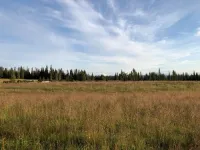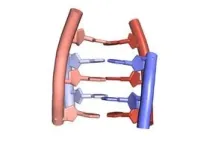(Press-News.org) Climate change will move and reduce the land suitable for growing food and timber, putting the production of these two vital resources into direct competition, a new study has found.
The sight of vineyards in Britain is becoming more common as hotter summers create increasingly suitable conditions for growing grapes. But behind this success story is a sobering one: climate change is shifting the regions of the world suitable for growing crops.
Researchers at the University of Cambridge have uncovered a looming issue: as the land suitable for producing our food moves northwards, it will put a squeeze on the land we need to grow trees. The timber these trees produce is the basis of much of modern life – from paper and cardboard to furniture and buildings.
They say that the increasing competition between land for timber production and food production due to climate change has, until now, been overlooked – but is set to be an emerging issue as our demand for both continues to increase.
Under the worst-case scenario for climate change, where no action is taken to decarbonise society, the study found that over a quarter of existing forestry land – around 320 million hectares, equivalent to the size of India – will become more suitable for agriculture by the end of the century.
Most forests for timber production are currently located in the northern hemisphere in the US, Canada, China and Russia. The study found that 90% of all current forestry land that will become agriculturally productive by 2100 will be in these four countries.
In particular, tens of millions of hectares of timber-producing land across Russia will become newly suitable for agriculture – more than in the US, Canada and China put together – with conditions becoming favourable for potato, soy, and wheat farming.
“There’s only a finite area of suitable land on the planet where we can produce food and wood - two critical resources for society. As climate change worsens and agriculture is forced to expand northwards, there’s going to be increasing pressure on timber production,” said Dr Oscar Morton, a researcher in the University of Cambridge’s Department of Plant Sciences who co-led the study.
“We’ve got to be thinking fifty years ahead because if we want timber in the future, we need to be planting it now. The trees that will be logged by the end of this century are already in the ground – they’re on much slower cycles than food crops,” said Dr Chris Bousfield, a postdoctoral researcher in the University of Cambridge’s Department of Plant Sciences and co-leader of the study.
Global food demand is projected to double by 2050 as the population grows and becomes more affluent. Global wood demand is also expected to double in the same timeframe, in large part because it is a low-carbon alternative to concrete and steel for construction.
Shifting timber production deeper into boreal or tropical forests are not viable options, because the trees in those regions have stood untouched for thousands of years and logging them would release huge amounts of carbon and threaten biodiversity.
“A major environmental risk of increasing competition for land between farming and forestry is that wood production moves into remaining areas of primary forest within the tropics or boreal zones. These are the epicentres of remaining global wilderness and untouched tropical forests are the most biodiverse places on Earth. Preventing further expansion is critical,” said David Edwards, Professor of Plant Ecology in the University of Cambridge’s Department of Plant Sciences and senior author of the study.
To get their results, the researchers took satellite data showing intensive forestry across the world and overlaid it with predictions of suitable agricultural land for the world’s key crops -including rice, wheat, maize, soy and potato - in the future under various climate change scenarios.
Even in the best-case scenario, where the world meets net zero targets, the researchers say there will still be significant future changes in the regions suitable for timber and crop production.
The study is published today in the journal Nature Climate Change.
Timber production contributes over US $1.5 trillion per year to national economies globally. Heatwaves and associated wildfires have caused huge recent losses of timber forests around the world. Climate change is also driving the spread of pests like the Bark Beetle, which attack trees.
Climate change is expected to cause areas in the tropics to become too hot and inhospitable for growing food, and make large areas of southern Europe much less suitable for food and wood production.
“Climate change is already causing challenges for timber production. Now on top of that there will be this increased pressure from agriculture, creating a perfect storm of problems,” said Bousfield.
“Securing our future wood supply might not seem as pressing as securing the food we need to eat and survive. But wood is just as integrated within our daily lives and we need to develop strategies to ensure both food and wood security into the future,” said Morton.
END
Global timber supply threatened as climate change pushes cropland northwards
2024-08-29
ELSE PRESS RELEASES FROM THIS DATE:
Researchers identify basic approaches for how people recognize words
2024-08-29
University of Iowa researchers have defined how people recognize words.
In a new study with people who use cochlear implants to hear, the researchers identified three main approaches that people with or without hearing impairment use to recognize words, an essential building block for understanding spoken language. Which approach depends on the person, regardless of hearing aptitude or ability: Some wait a bit before identifying a word, while others may tussle between two or more words before deciding which word has been heard.
When a person hears a word, the brain briefly considers hundreds, if not thousands, ...
Experts call for routine measurement of lipoprotein (a) levels
2024-08-29
London, UK: Heart experts say that everyone should have their levels of lipoprotein (a) (Lp(a) measured routinely at least once in life, following research from one of the most populous EU countries, Poland, that shows how common high levels of Lp(a) are in the general population.
The findings come from several studies presented at the European Society of Cardiology (ESC) Congress taking place in London, UK, this week [1] and published in two journals: Progress in Cardiovascular Disease and Archives of Medical Sciences [2].
LP(a) is a parcel of fats (also known ...
Land-sea “tag-team” devastated ocean life millions of years ago reveal scientists
2024-08-29
Scientists have revealed how a “tag-team” between the oceans and continents millions of years ago devastated marine life – and altered the course of evolution on Earth.
Their study has unearthed a new explanation for a string of severe environmental crises, called oceanic anoxic events, which happened between 185 and 85 million years ago.
These occurred when the seas became critically depleted of dissolved oxygen.
Experts from the University of Southampton, which led the study, said these events triggered significant biological upheavals, including ...
Researchers map 50,000 of DNA’s mysterious ‘knots’ in the human genome
2024-08-29
Researchers map 50,000 of DNA’s mysterious ‘knots’ in the human genome
Innovative study of DNA’s hidden structures may open up new approaches for treatment and diagnosis of diseases, including cancer.
DNA is well-known for its double helix shape. But the human genome also contains more than 50,000 unusual ‘knot’-like DNA structures called i-motifs, researchers at the Garvan Institute of Medical Research have discovered.
Published today in The EMBO Journal is the first comprehensive map of these unique DNA structures, shedding light on their potential roles in gene regulation involved in disease.
In a landmark 2018 study, Garvan scientists ...
Can fungi turn food waste into the next culinary sensation?
2024-08-29
Chef-turned-chemist Vayu Hill-Maini has a passion: to turn food waste into culinary treats using fungi.
One of his collaborators is Rasmus Munk, head chef and co-owner of the Michelin two-star restaurant Alchemist in Copenhagen, who serves a dessert — orange-colored Neurospora mold grown on rice — inspired by Hill-Maini.
For the past two years, Hill-Maini has worked with a team of chefs at Blue Hill at Stone Barns, a Michelin two-star restaurant in Pocantico Hills, New York, to generate tasty morsels from Neurospora mold grown on grains and pulses, including the pulp left over from making oat ...
Women with endometriosis at greater associated risk of heart attack and stroke
2024-08-29
London, United Kingdom – 29 Aug 2024: According to research presented at ESC Congress 2024,1 women with endometriosis have a 20% greater risk of significant cardiac outcomes compared with women without endometriosis.
“For decades, cardiovascular disease (CVD) has been thought of as a man’s disease and risk factors have been considered from the male perspective, for example, including erectile dysfunction in guidelines on CVD risk assessment.2 Yet, 1 in 3 women die from CVD and 1 in 10 women suffer from ...
Catching up on sleep on weekends may lower heart disease risk by up to 20%
2024-08-29
London, United Kingdom – 29 August 2024: The demands of the working week, often influenced by school or work schedules, can lead to sleep disruption and deprivation. However, new research presented at ESC Congress 2024 shows that people that ‘catch up’ on their sleep by sleeping in at weekends may see their risk of heart disease fall by one-fifth.
“Sufficient compensatory sleep is linked to a lower risk of heart disease,” said study co-author Mr Yanjun Song of the State Key Laboratory ...
Quitting smoking nearly halves heart attack risk, cutting down does little
2024-08-29
London, United Kingdom – 29 August 2024: According to research presented today at ESC Congress 2024,1 patients with stable coronary artery disease who quit smoking at any timepoint after their diagnosis reduced their risk of a major event by almost 50%. In contrast, there was minimal impact on cardiovascular risk in patients who reduced their smoking habits.
The international CLARIFY registry (prospeCtive observational LongitudinAl RegIstry oF patients with stable coronary arterY ...
Children contribute to group projects when there are clear and common goals
2024-08-29
Children can work together to reach a target that benefits a whole group even if it is at a personal cost to themselves, a new study has shown.
Researchers invited groups of six to 10-year-olds to take part in a game where they were each given containers of water and could decide how much of it to offer into a common pool.
If the group contributed a certain amount of water it resulted in benefits for the whole group, but children also obtained benefits for any water they kept.
At the same time, the ...
Dine on DNA: Compounds from nucleic acids in food show anticancer effects
2024-08-29
When people eat, they ingest the nucleic acids that reside in all living things. The compounds in these acids could inhibit the growth of cancer cells, according to findings published in PLOS ONE by Osaka Metropolitan University Associate Professor Akiko Kojima-Yuasa of the Graduate School of Human Life and Ecology and colleagues.
Consuming nucleic acids found in food has been shown to boost the immune system and prevent some diseases. The nucleotides and nucleosides that result from digesting the acids are largely responsible for these beneficial effects.
Professor ...








